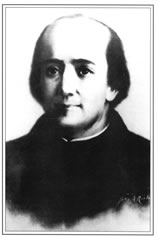| The text of Marquette's journal presented in this
publication is based on a translation of the Relations from The
Jesuit Relations and Allied Documents by Reuben G. Thwaites, published
in 1902. The authorship of the journal has been disputed by scholars
for the past century.
Part One of the journal, which begins in St. lgnace on May 17,
1673 is assumed to be written by Marquette and edited by Dablon.
It consists
of ten sections written in the first person and attributed to Marquette.
The titles are in the third person and are probably a later addition
by Dablon to make the journal more readable. The majority of Marquette's
writings detail the exciting journey down the Mississippi River to
the Arkansas River and offer a brief outline of the return trip to
Green Bay.
The crew traveled from St. Ignace along the shore of Lake Michigan
to Green Bay. Here, Marquette noted the rise and fall of the tides,
and the Folle Avoine tribe warned the explorers of a huge river inhabited
by demons, monsters and Indians who would "break their heads." Stopping
briefly at the St. Francis Xavier mission, the expedition traveled
west down the Fox River. The tribe of the Fire Nation provided guides
for the pottage to the Wisconsin River. Marquette noted that, for
the first time, they were traveling on waters that did not flow toward
Quebec a major turning point for the explorers.
On June 17, 1673, the expedition entered the Mississippi River.
A week later footprints were discovered on the river's edge.
In one
of the journal's more dramatic moments, Marquette and Jolliet follow
the footprints into the wilderness, leaving the five voyageurs to
guard the two canoes. Marquette had found the Illinois he sought.
His visit was highlighted by an eloquent speech of an Illinois elder, "I
low beautiful the sun is, O Frenchman when thou comest to visit us." It
is here that Marquette received a calumet to ward off danger.
As the two canoes journeyed further down the Mississippi, the men
encountered a huge monster painted on a rock and a powerful "demon" whirlpool
where the great river met with the Missouri River. As the explorers
traveled south of the Ohio River, real monsters took hold of them
mosquitoes so fierce that the men draped themselves with their canoe
sails for protection.
The party encountered two unfriendly Indian tribes. One tribe possessed
guns, indicating Spanish contact. Each time the canoes approached
the shore, Marquette held the calumet high. The Indians responded
peacefully and the canoes landed in relative safety.
On July 17, 1673, the decision was made to begin the journey back
to Green Bay. The main concerns were the possibilities of being captured
by the Spanish and losing the valuable notes and maps of the journey.
Section Ten of the journal gives a brief account of the trip back,
including the obvious difficulty of paddling a canoe upstream. Despite
this, Marquette retained his enthusiasm, noting the fertile land
and abundant wildlife. As the explorers followed the Illinois River
to Lake Michigan, they discovered a second canoe route to the east,
which would be important to future traders and settlers. The party
encountered another Illinois tribe at Kaskaskia and Marquette vowed
to return to establish a mission there. The explorers reached Green
Bay in September 1673. They had traveled more than 2,500 miles since
they had left St. Ignace five months earlier.
Part Two of this publication begins in the summer of 1674 and consists
of Marquette's unfinished journal and notes by Dablon. Although Marquette
was sick with a serious stomach disorder, he was driven to establish
a mission in Kaskaskia. The tone of the account is dominated by the
hardships of sickness, travel and winter camp. The winter of 1674
was spent in a small camp at present day Chicago. By April 1675,
Marquette and his two voyageurs were ready to journey to Kaskaskia.
Part Three of this publication is written by Dablon. In his journal
we observe a sick, but inspired, Marquette the missionary,
not Marquette the explorer. In Kaskaskia, Marquette established La
Conception, his last mission. We also learn of the circumstances
of Marquette's death on May 18, 1675, and his reburial in 1677. The
end of the journal clearly demonstrates Marquette's love of his fellow
man and the strength of his religious beliefs. It also communicates
the love and respect that the French and Indians had for Marquette.
To the present day reader, Marquette's and Dablon's writings provide
a window to the past that reveals many attitudes and beliefs unique
to the French colonial era. They also disclose feelings and emotions
that bridge more than three centuries allowing us to see Marquette
the seventeenth century man beyond Marquette the twentieth century
legend.
The journal presented here is little changed from the 1902 English
translation by Reuben G. Thwaites in The Jesuit Relations and Allied
Documents. The original spelling and punctuation have been retained;
only capitalization has been changed to allow easier reading. The
journal's original subtitles introduce each of this book's chapters.
The attitudes and language of the journal including the use of the
term "savages" for North American Indians are strictly
those of the seventeenth century.
| 

